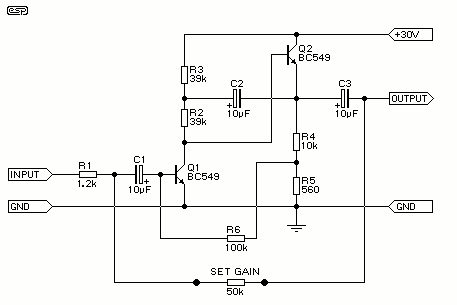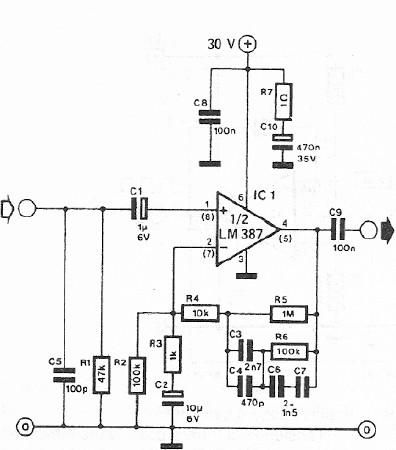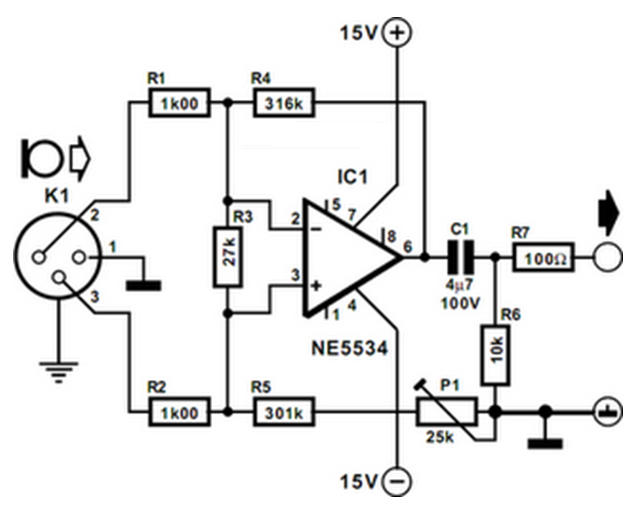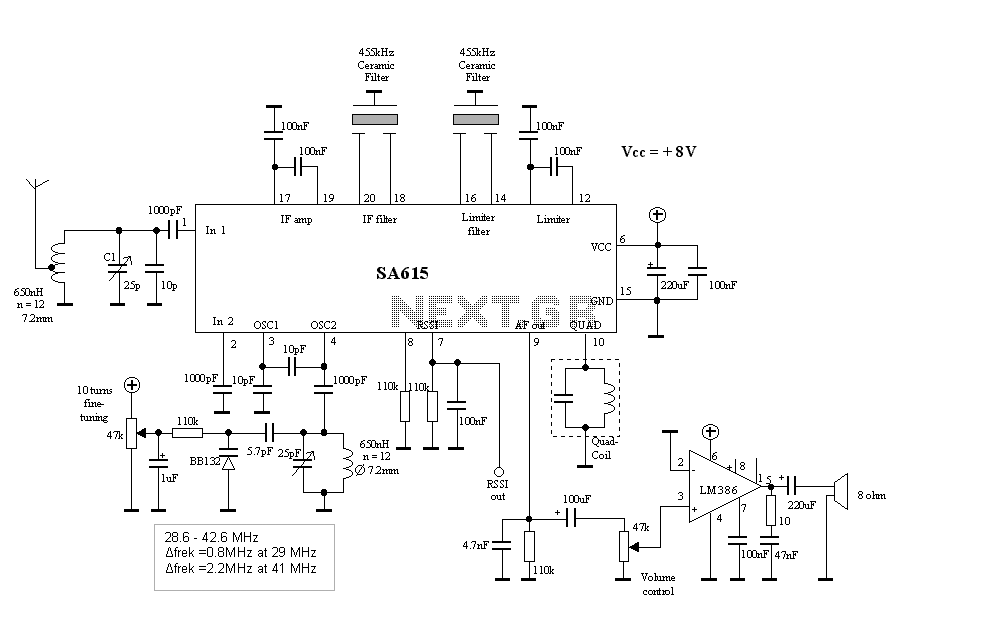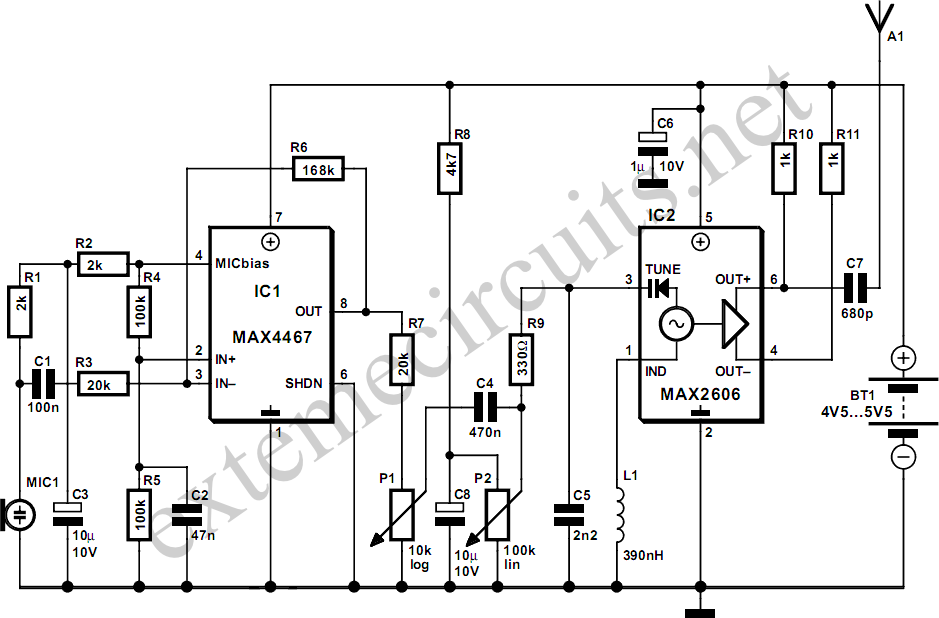
Scramble phone
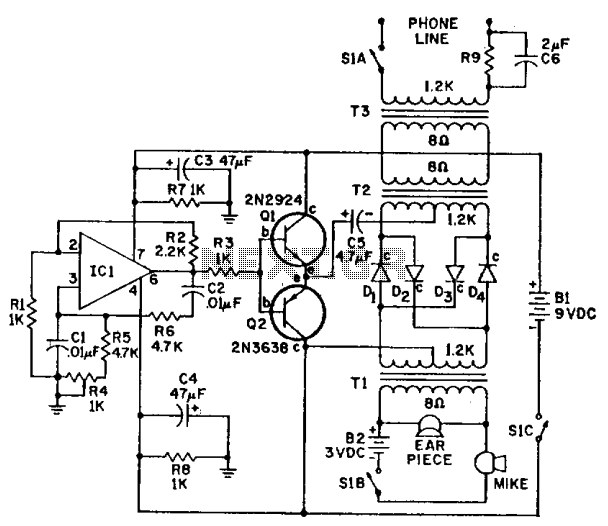
IC-1 and the associated circuitry form a stable audio tone generator that feeds a buffer amplifier, Q1 and Q2. The tone output is taken from the emitters of the transistor pair to supply a carrier voltage for a balanced modulator made up of four diodes—D1 through D4—and T1 and T2. If the two transformers and the four diodes are perfectly matched (which is almost impossible to achieve and not necessary in any case), no carrier will appear at the input or output of T1 or T2. In a practical circuit, a small amount of unbalance will occur and produce a low-level carrier tone at the input and output of the balanced modulator. A telephone carbon microphone and earpiece are connected to the low impedance winding of T1, with a three-volt battery supplying the necessary microphone current. Trim potentiometer R4 is used to make a fine frequency adjustment of the oscillator so that two scrambler units may be synchronized to the same carrier frequency. R6 limits line current to 25 mA.
The circuit described involves an integrated circuit (IC-1) that functions as a stable audio tone generator. This generator produces a consistent audio frequency output, which is then buffered by two transistors, Q1 and Q2. The output from these transistors is taken from their emitters, providing a reliable carrier voltage for the balanced modulator circuit composed of four diodes (D1 to D4) and two transformers (T1 and T2).
In an ideal scenario where all components are perfectly matched, the balanced modulator would not produce any carrier signal at either the input or output of the transformers. However, in practical applications, slight mismatches between the components are inevitable, leading to the generation of a low-level carrier tone that can be observed at both the input and output of the modulator.
The circuit also incorporates a telephone carbon microphone connected to the low impedance winding of transformer T1. This microphone requires a three-volt battery to provide the necessary current for operation. The trim potentiometer R4 is an essential component for fine-tuning the oscillator frequency, enabling synchronization between two scrambler units to operate at the same carrier frequency. Additionally, resistor R6 is included in the design to limit the line current to a maximum of 25 mA, ensuring that the circuit operates within safe current levels and preventing potential damage to the components.
Overall, this circuit design is crucial for applications requiring audio tone generation and modulation, particularly in communication systems where synchronization and stability are paramount.IC-1 and the associated circuitry form a stable audio tone generator that feeds a buffer amplifier, Ql and Q2. The tone output is taken from the emitters of the transistor pair to supply a carrier voltage for a balanced modulator made up of four diodes—Dl through D4—and Tl and T2.
If the two transformers and the four diodes are perfectly matched (which is almost impossible to achieve and not necessary in any case) no carrier will appear at the input or output of Tl or T2. In a practical circuit, a small amount of unbalance will occur and produce a low-level carrier tone at the input and output of the balanced modulator. A telephone carbon mike and earpiece are connected to the low impedance winding of 1, with a three volt battery supplying the necessary mike current.
Trim potentiometer R4 is used to make a fine frequency adjustment of the oscillator so that two scrambler units may be synchronized to the same carrier frequency. Rg limits line current to 25 mA.
The circuit described involves an integrated circuit (IC-1) that functions as a stable audio tone generator. This generator produces a consistent audio frequency output, which is then buffered by two transistors, Q1 and Q2. The output from these transistors is taken from their emitters, providing a reliable carrier voltage for the balanced modulator circuit composed of four diodes (D1 to D4) and two transformers (T1 and T2).
In an ideal scenario where all components are perfectly matched, the balanced modulator would not produce any carrier signal at either the input or output of the transformers. However, in practical applications, slight mismatches between the components are inevitable, leading to the generation of a low-level carrier tone that can be observed at both the input and output of the modulator.
The circuit also incorporates a telephone carbon microphone connected to the low impedance winding of transformer T1. This microphone requires a three-volt battery to provide the necessary current for operation. The trim potentiometer R4 is an essential component for fine-tuning the oscillator frequency, enabling synchronization between two scrambler units to operate at the same carrier frequency. Additionally, resistor R6 is included in the design to limit the line current to a maximum of 25 mA, ensuring that the circuit operates within safe current levels and preventing potential damage to the components.
Overall, this circuit design is crucial for applications requiring audio tone generation and modulation, particularly in communication systems where synchronization and stability are paramount.IC-1 and the associated circuitry form a stable audio tone generator that feeds a buffer amplifier, Ql and Q2. The tone output is taken from the emitters of the transistor pair to supply a carrier voltage for a balanced modulator made up of four diodes—Dl through D4—and Tl and T2.
If the two transformers and the four diodes are perfectly matched (which is almost impossible to achieve and not necessary in any case) no carrier will appear at the input or output of Tl or T2. In a practical circuit, a small amount of unbalance will occur and produce a low-level carrier tone at the input and output of the balanced modulator. A telephone carbon mike and earpiece are connected to the low impedance winding of 1, with a three volt battery supplying the necessary mike current.
Trim potentiometer R4 is used to make a fine frequency adjustment of the oscillator so that two scrambler units may be synchronized to the same carrier frequency. Rg limits line current to 25 mA.

